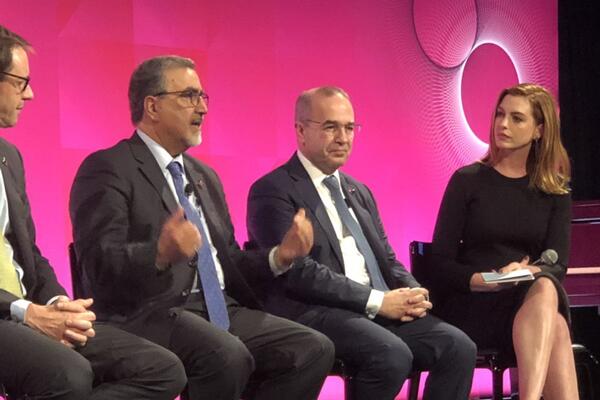
Gender equity isn’t a goal for tomorrow, it’s a goal forever
Campus HeForShe #GetFreeTour kick-off outlines how smashing gender inequity begins on campus

Campus HeForShe #GetFreeTour kick-off outlines how smashing gender inequity begins on campus
By University RelationsThe first version of Siri didn’t recognize a woman's voice.
This fact appalled many in the room, but it likely surprised few of the leaders, students, faculty, staff and community partners gathered on Waterloo’s campus as part of HeforShe’s latest Get Free university tour. Nearly everyone seemed in agreement, we’ve come a long way towards equity for all genders, but there is a long way to go.
“We want that change, not just for this generation or the next, but forever,” University of Waterloo President Feridun Hamdullahpur told a room of more than 200 students, faculty, staff and guests who had gathered to not only celebrate Waterloo’s role as the first stop on the five-campus Canada-wide tour, but to outline the important work that still remains. “This is most important for our students, who will build this world.”
Three students in particular were identified as being the kind of builders the future needs. Emma Moorehouse, Darby Grech and Grace Woodliffe were all provided scholarships by HeForShe Champion DeBeers.
University campuses like Waterloo are uniquely positioned to help change attitudes of students who may have found themselves free from their parents for the first time, but not free from the gendered violence, bias and discrimination that still haunts our society.
“The university is a microcosm of the wider society,” said Sara Casselman, executive director of the Sexual Assault Support Centre of Waterloo Region. “University in particular is a transformative time. That’s why it’s really important that a university is doing this.”
Casselman explained that women are more likely to experience sexual violence when starting university. However as nearly everyone involved in the event explained, this gendered violence is not a female problem, it’s a problem that impacts us all.
“Our burdens are as intertwined as our common destiny,” said actor, journalist and gender equity advocate Edgar Ramirez, who along with Elizabeth Nyamayaro, Senior Advisor to the Under-Secretary-General and Executive Director of UN Women, were also on Waterloo’s campus to kick off the Canadian leg of the #GetFreeTour.
“Men are told they need to be the ultimate provider and if they are not then they’re a complete failure. There is nothing more delusional or paralyzing than what I just described,” said Ramirez.
The actor added that often men’s repressed feelings manifest as anger or isolation, this in turn may lead to expressions of violence and anger.
“We need to pull down these social norms so we can all be free to be our true selves. Whatever action I take to free you also frees me,” he said.
Taking action to correct its gender imbalance was exactly why Waterloo became a HeForShe champion. Waterloo established three goals: To boost female enrolment in STEM outreach programs, hire more female faculty members and boost female participation in academic and senior leadership. All three goals have been achieved since signing on to HeForShe in May 2015.
“We needed it, the world needed it,” said Hamdullahpur. “It doesn’t have to be women defending gender initiatives, it’s all of our responsibility. We’ve met our ambitious and reasonable goals. There was no other option. We didn’t take a minute to sit down and celebrate those goals.”

Read more
Winners will be recognized at the International Women’s Day Dinner

Read more
HeForShe inspired event allows students, staff and faculty to brainstorm ideas toward a safer campus community.

Read more
Academy Award-winning actress Anne Hathaway thanks the University of Waterloo for being a “disruptive champion” in the movement for gender equality at UN Women’s summit
The University of Waterloo acknowledges that much of our work takes place on the traditional territory of the Neutral, Anishinaabeg, and Haudenosaunee peoples. Our main campus is situated on the Haldimand Tract, the land granted to the Six Nations that includes six miles on each side of the Grand River. Our active work toward reconciliation takes place across our campuses through research, learning, teaching, and community building, and is co-ordinated within the Office of Indigenous Relations.